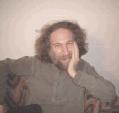
 |
|
|
Fred Collopy Ashok Goel Sungwook Yoon Andrew Warr Mary Lou Maher Bill Mitchell Gerhard Fischer Larry Leifer Roger Dannenberg Ben Shneiderman Roger Malina Chris Bregler John Gero Mark d'Inverno Thomas Hewett Christopher Jaynes Ken Perlin Dana Plautz Rob Saunders Scott Snibbe Kumiyo Nakakoji Michael Leyton Pamela Jennings Mark Gross Steven Smith Ruzena Bajcsy Rob Woodbury Terry Winograd Hal Eden Tristan Jehan Holger Dick Umer Farooq Alex Ivanov Michael Prilla Klara Nahrstedt Dan Ventura Tobias Hollerer Alan Sondheim Sandy Baldwin Wassim Jabi Lee Spector Jon Schull Eric Nichols Douglas Hofstadter Luz-Maria Jimenez Titus Noel Daryl Hepting H. Quynh Dinh Chris Vigorito Mitra Debasis Janet Burge Matthew Clark Lee Boot Brad Myers Sheila Tejada Ellen Yi-Luen Do Aditya Johri Young Joon Kim |
 Mark Gross Architecture, Carnegie Mellon University http://www.andrew.cmu.edu/user/mdg2/ Mark D Gross’s area of research is design methods and computational means. He has worked on constraint programming language for design, sketch recognition and analysis, tangible interaction, and architectural robotics. His current research, exploring the design space of next-generation computationally enhanced construction kit toys and craft for teaching and learning science, technology, engineering, and mathematics is supported by an Information Technology Research grant from NSF. Gross received a Bachelor of Science in Architectural Design (1978) from the Massachusetts Institute of Technology, and a Ph.D. in Design Theory and Methods from the same institution in 1986. While an undergraduate student he worked in Negroponte’s Architecture Machine Group on interactive models and tools for architectural design. After completing the undergraduate degree Gross worked at the MIT Logo Laboratory on personal computer implementations of the Logo programming language for children. His doctoral work, supervised by N. John Habraken, Aaron Fleisher, and Seymour Papert, developed a model of designing as exploring constraints and a software strategy to support this model. During this time Gross also worked at the Atari Cambridge Research Laboratory on educational computing. From 1986-1988 Gross worked as a post-doctoral fellow at MIT with Habraken on "Concept Design Games," and with Fleisher, Donald Schön, and Larry Bucciarelli on "Designing and Designing Knowledge in Engineering and Architecture". From 1988-1990, with Habraken, he consulted for the Shimizu Construction Corporation on computer tools for spatial coordination in architectural design. Gross taught at the University of Colorado from 1990-1999 in the College of Environmental Design, which became the College of Architecture and Planning, where he was also a fellow of the Institute of Cognitive Science. He also briefly held a joint position in the Department of Civil, Environmental, and Architectural Engineering. From 1999-2004 he taught at the University of Washington, Seattle in the Department of Architecture, where held joint appointments in the Departments of Landscape architecture and Computer Science and Engineering. He helped found a PhD program in Planning and Design at Colorado, and another in Built Environment at Washington. He joined Carnegie Mellon’s School of Architecture faculty in 2004 where he teaches in the computational design graduate program. Last modified 13 June 2007 at 4:49 pm by haleden |